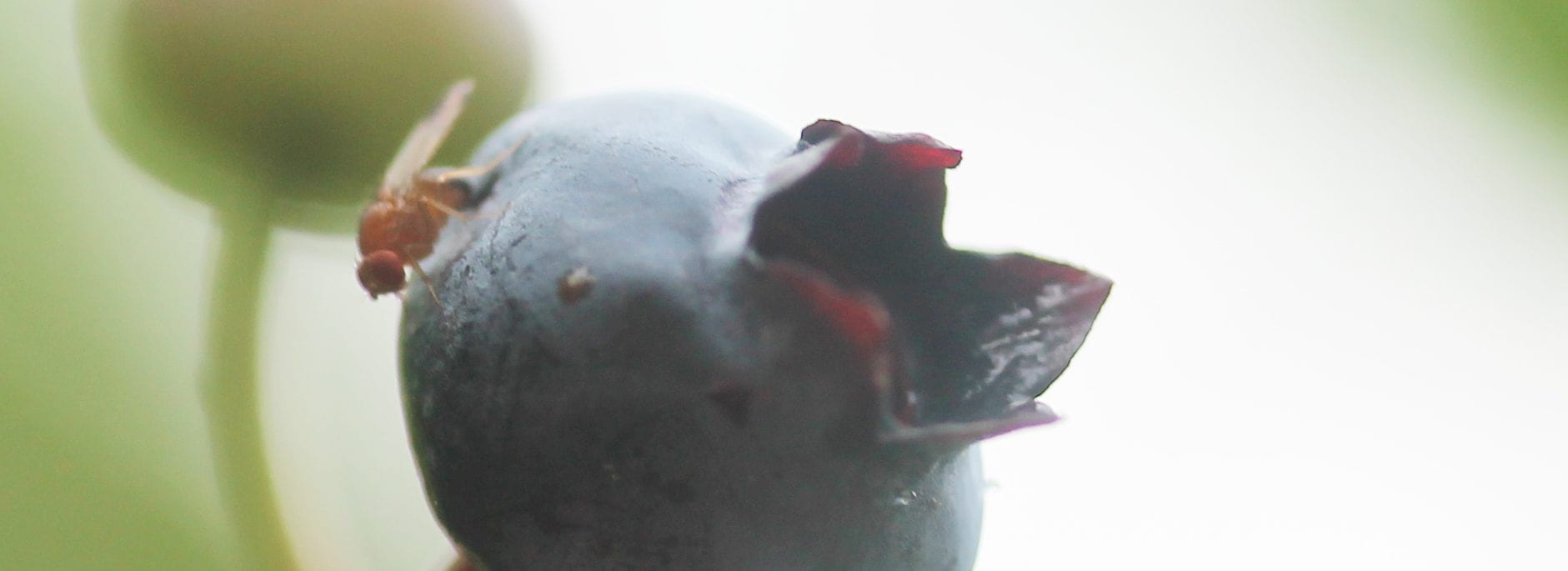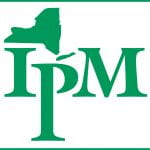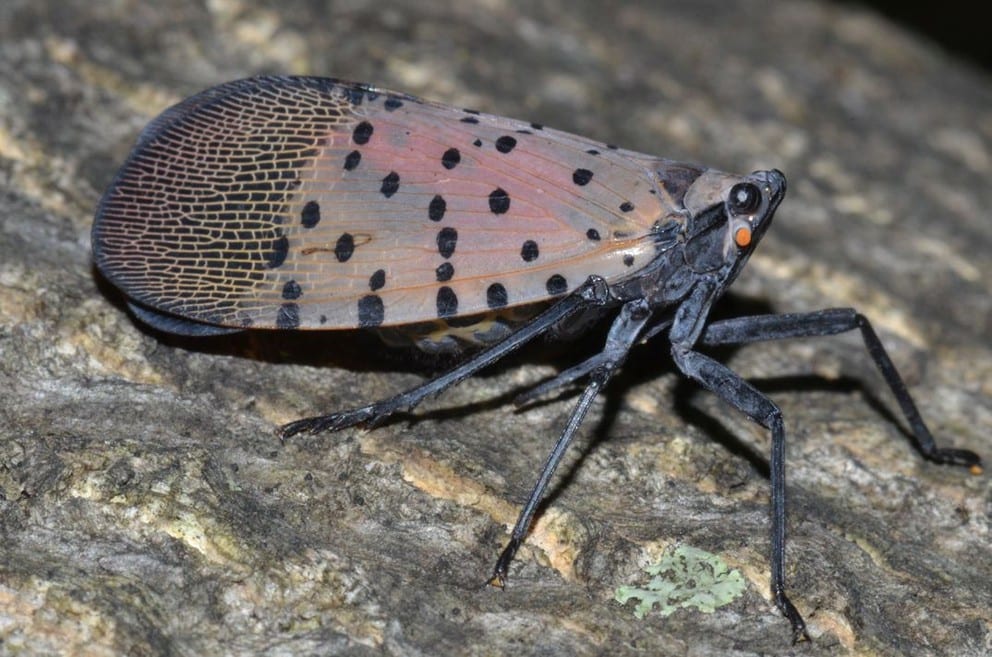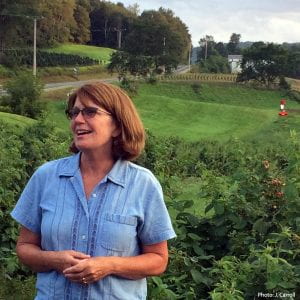If you live in a region bordering southwest NY or eastern NY these two simultaneous workshops might be of interest to you! Wednesday, September 15 from 4-6 pm. The Stephentown, NY Workshop has been rescheduled for Tuesday, October 5, due to severe weather on September 15, 2021.
Join Cornell Berry Team Members for a two-hour review of Spotted Wing Drosophila (SWD) management techniques. We'll cover the basics of SWD monitoring of adult and larval populations and also discuss implementing a pesticide program. Two locations — you choose the best for you:
- The Berry Patch, 15589 State Route 22, Stephentown, NY 12168 - now on October 5.
- Abers Acres, Abers Acres, Route 394, Kennedy, NY 14747
The program will focus on what has been learned about designing an exclusion netting support system that provides long term control of SWD and maximum utility for berry farmers.
Exclusion netting is being used on field blueberries where it controls SWD while also excluding birds and moderating impacts of hail and heavy rain. Raspberries and strawberries also benefit from exclusion netting on the sides of high tunnels.
1.5 DEC credits available in categories 1A, 10, and 22
REGISTER HERE - https://enych.cce.cornell.edu/event_preregistration_new.php?id=1567

AGENDA - Stephentown, 4-6 PM, Wednesday, September 15 Now on Tuesday, October 5
4:00 pm Welcome and Introductions & NYS DEC credit sign-up - Laura McDermott, CCE ENYCHP
4:05 pm Brief Overview of SWD - Laura McDermott, CCE ENYCHP. Insect monitoring, fruit infestation monitoring, insecticide management and cultural management techniques will be discussed
4:20 pm Overview of Exclusion Netting - Dale Ila Riggs, The Berry Patch and Ted Storozum, TekKnit, Quebec CA. Brief review of work undertaken and effectiveness of netting in open field and high tunnel systems. Discussion of adaptations made to netting material and the need for structural design.
4:50 pm Structural Considerations when Installing Exclusion Netting - Chris Callahan, University of Vermont and Paul Lucas from Gintec, Ontario, CA. The past two seasons have provided lots of new information about designing the support structure for Exclusion Netting. We have been able to revise the design leading to a more lean and lower cost structure as we adapt it from ginseng production systems. Gintec owner Paul Lucas has played a critical advisory role in this portion of the project and has decades of experience with protected agriculture systems. Cost information for the SWD exclusion netting and structure will be included.
5:20 pm Exclusion Netting on Fall Raspberries - Dale Ila Riggs, The Berry Patch. Research on using field netting for fall raspberries and incorporating it into a high tunnel system.
5:30 pm Views from Other Growers - TBD. Growers that have adopted exclusion netting will share their successes and struggles with the netting.
5:45 pm Hands-On Removal of Netting Attendees will watch and assist with removal of netting panels to better understand the requirements and ease of using netting. Netting storage and winter care will be discussed.
AGENDA - Kennedy, 4-6 PM, Wednesday, September 15
4:00 pm Welcome and Introductions & NYS DEC credit sign-up - Anya Osatuke, CCE Harvest NY
4:05 pm Brief Overview of SWD - Greg Loeb, Cornell University. Insect monitoring, fruit infestation monitoring, insecticide management and cultural management techniques will be discussed
4:20 pm Overview of Exclusion Netting - Greg Loeb and Stephen Hesler, Cornell University. Brief review of work undertaken and effectiveness of netting in open field and high tunnel systems. Discussion of adaptations made to netting material and the need for structural design.
4:50 pm Structural Considerations when Installing Exclusion Netting - Stephen Hesler, Cornell University and John Abers, Abers Acres. The past two seasons have provided lots of new information about designing the support structure for Exclusion Netting, but every farm is unique and Abers Acres owner will discuss how they installed the netting. This installation benefited from the lessons learned during the prior year's installation at The Berry Patch and uses fewer posts in the support structure leading to reduced cost and labor. Cost information about the SWD exclusion netting and structure will be included.
5:20 pm Exclusion Netting on Fall Raspberries - Greg Loeb, Cornell University. Research on using field netting for fall raspberries and incorporating it into a high tunnel system.
5:30 pm Views from Other Growers - TBD. Growers that have adopted exclusion netting will share their successes and struggles with the netting.
5:45 pm Hands-On Removal of Netting Attendees will watch and assist with removal of netting panels to better understand the requirements and ease of using netting. Netting storage and winter care will be discussed.
REGISTER HERE - https://enych.cce.cornell.edu/event_preregistration_new.php?id=1567
Thank you to the New York State Berry Growers Association for sponsoring these meetings. This research is partially funded with support from Northeast SARE.
This post was contributed by Laura McDermott and Anya Osatuke.







 For a snapshot view of advances in IPM and IPM stories, including our story about SWD in cherries, listen to the IPM Forum from 1 to 2 pm on November 13th.
For a snapshot view of advances in IPM and IPM stories, including our story about SWD in cherries, listen to the IPM Forum from 1 to 2 pm on November 13th.

 Despite decades of promoting school IPM, bed bugs, cockroaches, lice, and mice continue to be a problem in schools. Part of the issue is lack of implementation of proven IPM techniques such as exclusion. Part of the issue is that some pests, like bed bugs, German cockroaches and lice arrive in backpacks, delivered supplies, and directly on students and staff. While schools often have plans in place to address these pests when they are discovered, it will take a wider community effort to prevent their introductions. Join us and learn about proven school IPM tactics!
Despite decades of promoting school IPM, bed bugs, cockroaches, lice, and mice continue to be a problem in schools. Part of the issue is lack of implementation of proven IPM techniques such as exclusion. Part of the issue is that some pests, like bed bugs, German cockroaches and lice arrive in backpacks, delivered supplies, and directly on students and staff. While schools often have plans in place to address these pests when they are discovered, it will take a wider community effort to prevent their introductions. Join us and learn about proven school IPM tactics! NYS Pesticide Applicator recertification credits have been awarded for the following categories: Core, 3A, 3B, 7A, 7F, and 8.
NYS Pesticide Applicator recertification credits have been awarded for the following categories: Core, 3A, 3B, 7A, 7F, and 8.
 “Our office has received questions from a few New Yorkers who have received unsolicited packages allegedly sent from China that are marked as containing jewelry (or other items) but which actually contain plant seeds. Similar packages have been received in other states and the United States Department of Agriculture is investigating. People who receive seeds should not plant or handle the seeds. They should store them safely in a place children and pets cannot access and email USDA immediately at
“Our office has received questions from a few New Yorkers who have received unsolicited packages allegedly sent from China that are marked as containing jewelry (or other items) but which actually contain plant seeds. Similar packages have been received in other states and the United States Department of Agriculture is investigating. People who receive seeds should not plant or handle the seeds. They should store them safely in a place children and pets cannot access and email USDA immediately at